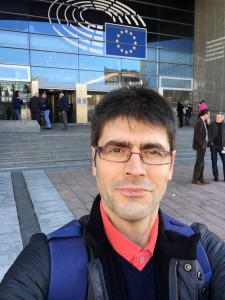The MEP-Scientist Pairing Scheme aims at enhancing mutual understanding and establishing a long-term, intensive cooperation between Members of the European Parliamant and researchers.

Dr Carlos Calderon
Dr Carlos Calderon, Senior Lecturer in Architecture, reflects here on his experience of the scheme to date.
“I am writing this note after my “Brussels week” and I can now say that this has been a very worthwhile experience. Without a doubt I would encourage anyone to do it.
Although my hopes of being successful in the selection process were pretty low, I did apply. To my surprise, out of 326 applicants I was one of the 30 scientists selected to work with an MEP and was paired with Merja Kyllönen from Finland, a former Finish minister.
The idea of the scheme is that a scientist (me in this case) will shadow the work of an MEP over the course of a week in Brussels. As part of this I would learn how to successfully interact with the policy-making process, while the MEP gains awareness of scientific practices as well as a better understanding of the scientist’s point of view.
My initial expectations were low as I was sceptical about whether the shadowing would be for show or a true reflection of the MEP working day. My experience has been the latter. Merja sent information to help me understand the working mechanism of the Parliament, particularly how the committees work and how policy departments interact with committees and MEPs. Whilst this was useful background information, for me, the real value of the scheme is in the one to one interaction with the MEP and his/her team
In my view, Merja is fantastic. Above all, she is a great person with strong ethical values and with a great team to support her: Piia, Tina, and Helena. I am very grateful that she allowed me to share in her daily routine. During my shadowing, I witnessed how she interacted with lobbyists, industries, political groups and internal EP mechanisms. At EU level, policy-making manifests itself as either Regulations: directly applicable; Directives: binding on results; Decisions: binding on those to whom addressed; and Recommendations, opinions: declaratory instruments.
Regardless of the legislative instrument that comes out of the policy-making process, it is clear that there is a myriad of pressures and that skilful politicians will constructively engage with all groups whilst being true to his or her values. How do we, as scientists, engage with this process in the EP? Indeed, I do now have a better idea how to do it at a practical level. But, I have been pleasantly surprised by the EP willingness to engage with the scientific community so if this is relevant to your work, just get in touch with the EP and its members.
I work in the area of Urban Energy, a nascent field of scientific enquiry that sits across urban planning, energy, and ICT. The aim is to provide vital support for evidence-based policy approaches to sustainable urban energy infrastructure transitions in Cities. For my research, the interface between science and public policy is important. Whilst I do have a good working knowledge at a local level, my understanding of that interface at European Union (EU) level was pretty limited. So I was intrigued by the innovative nature of this scheme and the possibility of working closely with a politician.”
Dr Calderon is Degree Programme Director for the MSc and MRes in Urban Energy.
